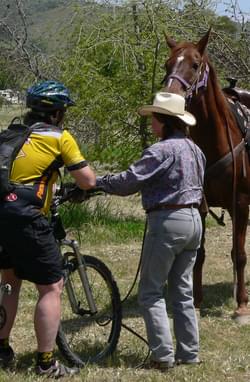




Link to Federal Highway Administration (FHWA) Guidance
Equestrian and other nonmotorized recreational use may be allowed on shared use paths and trails that use Federal-aid transportation funds.

The Federal Highway Administration (FHWA) receives occasional inquiries about equestrian and other nonmotorized use of facilities funded with Federal-aid highway program funds under Section 217 of title 23, United States Code, especially for projects using Transportation Enhancement funds.
Equestrian and other nonmotorized recreational use may be allowed on shared use paths and trails that use Federal-aid transportation funds. Federal transportation laws and regulations do not prohibit equestrians, in-line skaters, skateboarders, cross country skiers, snowshoe users, or other nonmotorized users on shared use paths or trails. States or local managers may choose to prohibit these uses; but it is a State or local determination, and not a Federal requirement. Various design options may allow equestrian use, such as providing both a paved path and an unpaved path within the same right-of-way.